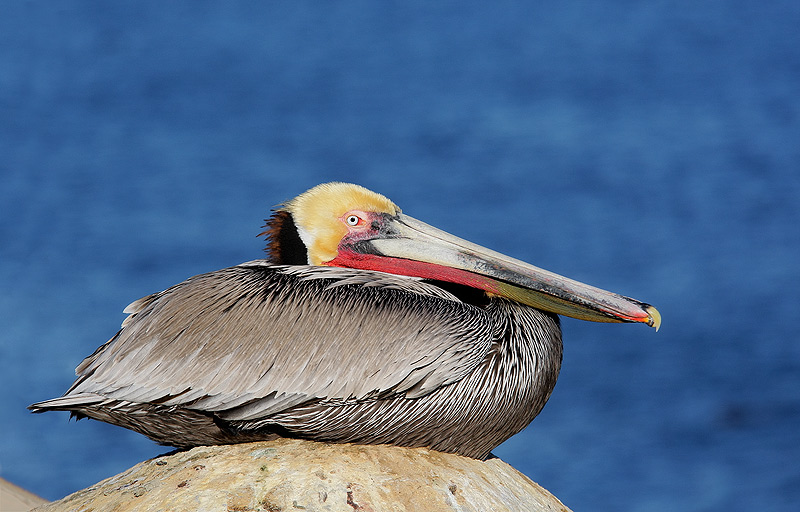
BIRDS AS ART BULLETIN #254
Visit www.birdsasart.com
La Jolla CLIFFS UPDATE
PHOENIX PROGRAM & IN THE FIELD WORKSHOP
BIRDPHOTOGRAPHERS.NET/IT AIN'T JUST BIRDS UPDATE
GALAPAGOS
JOB OPENING: VIREO COLLECTION MANAGER
INFRARED D-60 BODY FOR SALE
IPT UPDATES
Contact us by phone at 863-692-0906 (Eastern Time Zone) or by e-mail at birdsasart@att.net or @verizon.net. The att e-mail address is best from overseas.
We gladly
accept credit card orders by phone 8am till
You can use the PayPal links on the web site to order anything. Just type in the item(s) and the amount. If using your own PayPal account, please send to either of the e-mail addresses above.
Note: maximize this e-mail for best formatting.
Photographic theme: Assorted recent images.
Important Request: if responding to this e-mail, please take the time to delete all images and all irrelevant text.

Brown Pelican, perched on rock, La Jolla, CA
Image Copyright 2008: Arthur Morris/BIRDS AS ART
Canon 70-200mm
f/4 L IS lens with the 1.4X II TC (handheld at 241mm) and the EOS 1D Mark III.
ISO 400. Evaluative Metering +1/3 stop: 1/1600 sec. at f/6.3 set manually.
.
Regular readers and long-time students might be confused by the +1/3 exposure compensation for this image. Explanation: both the EOS1D MIII and the 1Ds MIII need more light than any Canon professional digital body that I have ever used. Note the clean, simple composition, the distant background, and the perfect head angle.
BIG LENS TRIPOD-HEAD REPORT
As 2008 unfolds, the vast majority of nature photographers using long telephoto lenses in North American are using one of three tripod heads. All are gimbal-type heads; the lens is mounted below a horizontal pivot axis and is free to swing. This prevents the dreaded ballhead flop where the photographer loses control of the lens and it flops--sometimes violently--to one side or the other. Each of the three popular gimbal type heads makes following birds in flight or animals in action a snap, and each reduces photographer fatigue which hits hard at neck and back muscles when working for extended periods of time with super-telephoto lenses. In January, 2008, we have been swamped with "Which is the best head?" questions so I decided to write the definitive essay and publish it here.
The three heads that I refer to are the (relatively new) Wimberley V-2 head, the old Wimberley head, and the Mongoose M3.5 Action head. Which one do I use? All three. Which one is best? No clear answer there. Which one is best for you? Your call. Read my comments below and make your decision.
First lets check out the weight and the cost of each.
Wimberley head (old): 3lbs 8 oz. Used only; hard to find.
Wimberley head V II (WH-200): 2lbs 8.5 ounces. $595 (Includes the Arca-Swiss compatible clamp/platform; P-40 or P-50 lens plate and bushings, if necessary, not included.)
Mongoose M3.5: 13.8 oz. $485. (Includes built-in Arca-Swiss compatible quick release clamp; a low foot is available for most big lenses/lens plate then not needed.)
Now let's look at each of these in the order that they came into my life. After (ridiculously) sticking with a ballhead for my big lenses for far too many years, I finally purchased a Wimberley head almost too many years ago to remember. Wow! It rendered my big lens weightless and you could photograph birds in flight with just one hand. I believe that the first model that I used was over four pounds. The next version was a bit lighter at 3.8 pounds; the folks at Wimberley simply had the heads manufactured of a lighter material. (At a NANPA Forum I signed my original with a silver pen for David Wimberley and the head was sold at a fund-raising auction right on the spot.) I used and loved the new lighter version for many years. My only complaint was with the weight, and with the fact that the horizontal panning knob (particularly) was difficult to use in cold weather when wearing gloves; for quite some time I suggested that it be replaced with a knurled and/or rubber coated knob. I remember seeing a few samples that were too small... I would learn later that one of the huge plusses of the old Wimberley heads was that it was easy to set a very light tension on either or both controls. This was beneficial when you were working at relatively slow shutter speeds and wanted a bit of tension to increase sharpness while still being able to follow slow-moving subjects. Being able to set just a bit of drag was also quite helpful on windy days. It helped to control the rig in the wind and kept you from getting smacked in the face if you were not holding onto your rig and not paying attention... With the tallest profile of the three heads, the old Wimberley was (and still is) the least sensitive of the three to torque when the rig was improperly balanced in the clamp. This same feature makes it a bit easier to balance the rig on an old Wimberley head than on either the V-II Wimberley or the M3.5.
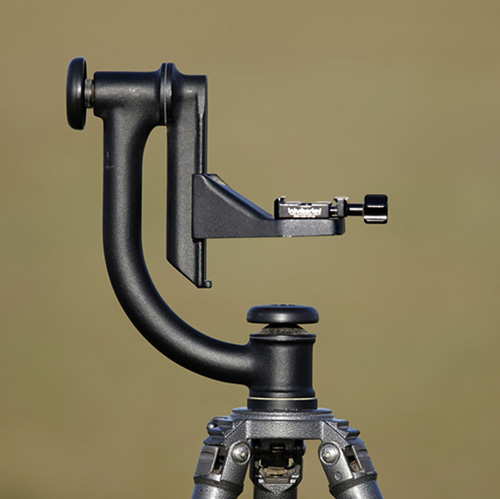
Old Wimberley Head
Image Copyright 2008: Arthur Morris/BIRDS AS ART
Note the adjustable clamp/platform and the position of the horizontal panning knob directly above the center of the tripod.
…..
Next was the Wimberley V-II head, a shade less than a full pound lighter than the previous version. With the onset of my shoulder problems a few years back, this was a most welcome improvement. The V-II had a much lower profile than the older version, and the swing arm was re-designed to match the width of all Arca-Swiss compatible plates. The horizontal panning knob was moved to the outside of the main assembly. Both locking knobs were knurled and rubber-coated and much easier to work in the cold. It took a while to get used to the new position of the horizontal panning knob but now I can switch back and forth between the VII and the old Wimberley head without losing a beat. With the shorter profile comes a shorter swing arm, and with the shorter swing arm, torque (as mentioned above) is greater and more noticeable with the V-II head than with the older Wimberley head even when the rig is perfectly balanced. (For maximum image sharpness all long lenses should be balanced perfectly fore and aft in the clamp at all times. Each time that an accessory is added or removed from the mix, the rig needs to be re-balanced. Period. Failure to do so equals sloppy technique and sloppy technique yields inferior quality images (but only 100% of the time). This increased torque will rarely affect sharpness for folks using perfect sharpness techniques. Users interested in maximizing image sharpness will want to take great care to ensure that when using the V-II heads their rigs are balanced perfectly at all times. In short, the old Wimberley head was a bit more forgiving of sloppy balancing and technique than the V-II.
My biggest complaint with early production model V-II heads was that it was nearly impossible to set a light tension on either the horizontal or vertical panning knobs. They were either totally loose or firmly locked, nothing in between. This was most problematic with horizontal panning. I mentioned this to Clay Wimberley and he suggested that if I swung the head very, very slowly as I tightened the knob that the problems would be minimized. It helped a bit but I soon realized that the beauty of the old head was that you could set a light tension on both knobs almost instantly without even thinking about it. After that Wimberley began doing some post-assembly tweaking and the problem was much reduced. (Again, this is a problem that only the sophisticated users with impeccable technique would notice; since the V-II head has been out, about two years I think, only two photographers have mentioned the problem: Todd Gustafson and James Shadle/aka Froggie.) For smoothly setting a light tension, however, the old Wimberley head will always have it over the V-II head, albeit by a slim margin.
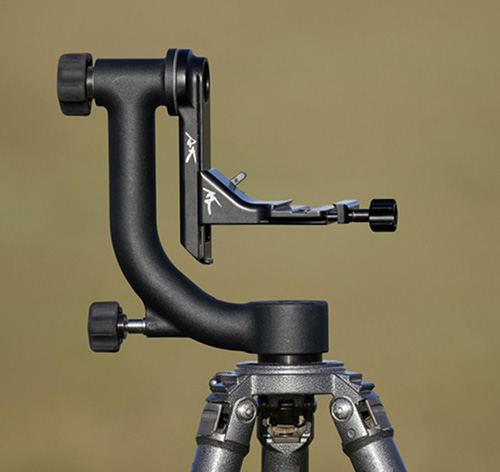
Wimberley V-II Head
Image Copyright 2008: Arthur Morris/BIRDS AS ART
Note the adjustable clamp/platform and the position of the horizontal panning knob on the outside of the main assembly. Both knobs are knurled and rubber-coated.
…..
The great advantage that both Wimberley heads have over the Mongoose M3.5 is that the the clamp/platform can be adjusted up or down. I would bet that more than 95% of Wimberley users (except for those who have been on BAA Instructional Photo-Tours) never make this adjustment and have no clue as to why it is important. Give up? After a rig is mounted on a Wimberley head you should point your lens up about 45 degrees toward the sky and let go of it. Unless you have adjusted the platform previously it will most likely swing back towards horizontal. (John Zeiss of 4th Generation Design, manufacturer of the Mongoose line, calls this the pendulum effect.) And the same will happen if you point it down towards the ground. What to do? If the clamp/platform is at the bottom of the swing arm (most likely), you will need to loosen the knob, raise the platform about an inch, tighten the knob, and repeat the tests as above. (Be absolutely sure that you loosen the knob for the platform and not the knob for the clamp! If you do the latter your lens may hit the ground with smashing results...)
Once you have raised the platform, point the lens up about 45 degrees towards the sky and then let it go. Then, again, point it down towards the ground and let it go. If the lens sits like a dog (stays pointed up or down) when you let it go, the height of the platform is perfect. If not, you will need to continue to experiment by either raising or lowering the platform (carefully) as needed. With some lenses, like the 600 f/4s, it is impossible to get the lens to sit like a dog without purchasing and installing a low foot. With the Canon 600 f/4L IS the rig is usually just short of perfect with the platfrom in the lowest position. (I do not like to use a low foot on my 600 as it puts me too close to the ground when working off a ground pod.)
Way back I was totally opposed to using a side-mounting gimbal head with the larger lenses because of the danger of dropping the lens when mounting it or when balancing it. But when Robert O'Toole began using a Mongoose M3.5 (the larger of the two Mongoose heads) more than a year ago I took a second look at the M3.5 Action head and began working with John Zeiss to improve it. Many demos later the product is greatly improved. With my off and on shoulder problems the lighter weight of the M3.5 is the huge attraction. As long as you take care when mounting and balancing your rig you should be fine. Perfect fore and aft balance with the M3.5 is even more important with this head because the clamp is in a fixed position; you cannot raise or lower it as you can with either of the Wimberley heads. The pendulum effect will be more noticeable on some lenses than on others. With my Canon 500mm f/4 L IS lens it is just a bit problematic.
How does the pendulum effect affect long lens photography? With a perfectly balanced rig on a Wimberley head that has the clamp/platform correctly adjusted (so that the lens sits like a dog when the lens is pointed up or down) you can point the lens down at a bird on the ground or up at a bird in a tree and let go of the rig without the lens moving at all. This helps folks with less than perfect sharpness technique to create sharp images... If I try the same thing with one of my 500mm f/4 L IS lenses on an M3.5, the lens will slowly begin to move, down when photographing a subject on the ground and up when working a bird above my position. This will affect sharpness only when you are working with the slower shutter speeds and only if you use poor sharpness techniques. Below is my preferred slow shutter speed sharpness grip with the 500 IS and the M3.5. Do note that I prefer--except when working a static subject at a slow shutter speed--to use my M3.5 without locking either the vertical or horizontal panning controls. In addition, the Mongoose M3.5 performs wonderfully well for flight photography.
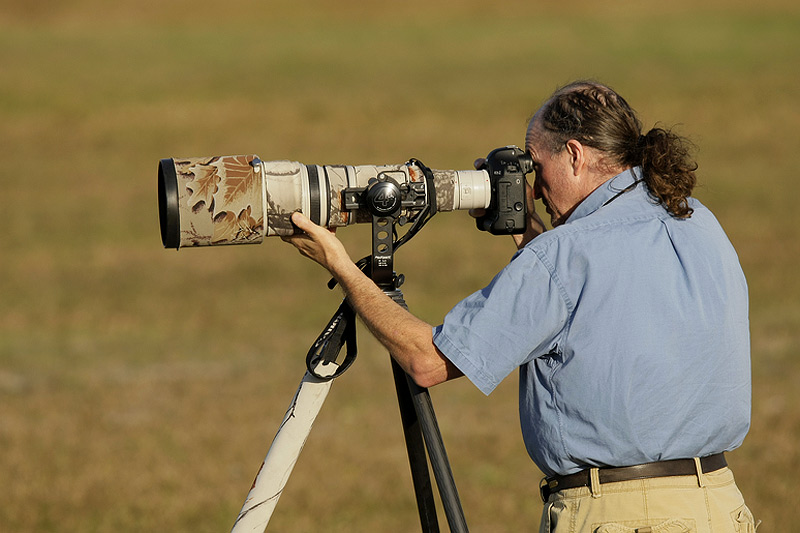
Maximum Sharpness Grip with the M3.5
Image Copyright 2008: Jim Litzenberg/BIRDS AS ART
What you cannot see in this image is that my forearm is resting firmly against the near leg and the platform of the Gitzo 3530 LSV CF tripod. This is the key to making sharp images at slow shutter speeds with the M3.5 and is similar to the technique that I use when I am working with either of the Wimberley heads. For photos on those techniques and a complete rundown on advanced sharpness techniques see pages 459-474 in The Art of Bird Photography II (916 pages on CD only): http://www.birdsasart.com/ABPII.htm
…..
Now here's the rub. With all versions of the M3.5 prior to the recently-released (JAN 2008) version (the only one with a black "4th" insert), it was easy to set a light tension on both the horizontal and vertical controls. With the older versions, some folks complained that it was impossible to lock the head tight enough to prevent a big lens from shifting while it was being carried on one's shoulder. This never bothered me much but I will admit that at times I did wish that the M3.5 controls would allow you to lock the head tight. I mentioned this to John Zeiss and--by changing the brake lining--he came up with the newest version. The new version locks totally with just finger pressure on the wing-bolts. The problem with the new version, however, is that it is almost impossible to set a light tension on the controls when working at slow shutter speeds or in windy conditions. I have spoken to John recently and he feels that the problem can be rectified with a post-assembly fix. I will keep folks advised.
Do know that the Mongoose M3.5 is far and away the best tripod-head for the extremely popular (for many good reasons) Nikon 200-400 VR lens. Well more than 90% of the folks who use this lens and tried a loaner M3.5 on an IPT purchased one on the spot. In the same vein I do not recommend the M3.5 for the 600mm f/4 lenses because their great weight and bulk make it very difficult to mount the lenses and balance rigs without dropping and damaging them. Robert O'Toole is young, strong, and experienced and despite his success with the 600 and the M3.5, I cannot recommend this combination. I firmly believe that the Wimberley VII head is best for all of the 600mm f/4 lenses.
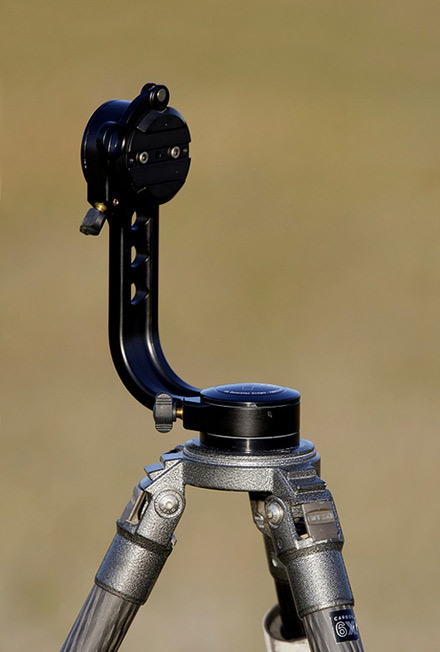
Mongoose M3.5 Action Head
Image Copyright 2008: Arthur Morris/BIRDS AS ART
Note the locking lever at the top of the assembly.
…..
So which tripod-head is best for your 500mm f/4 lens? I have no clue. At present I am using the Mongoose M3.5 a great majority of the time because of my shoulder problems, its light weight, and the ease with which it travels. By using excellent sharpness techniques (honed over the past 25 years) I am able to produce sharp images on a consistent basis even with slow shutter speeds. If I will be working close to the car and not walking much, such as at the Venice Rookery or the St. Augustine Alligator Farm, I will choose the Wimberley VII. And if I will be doing almost all flight photography and will again be close to my vehicle, I will get out the old Wimberley head, especially if wind is a factor. I ship it to Bosque each year as it is my favorite for flight photography as long as there is little or no walking involved. And I bring it to Africa because of its higher profile. As most folks are not in a position to own all three of these heads, they will need to carefully study the information above, borrow a head or three from a friend, and decide what is best for them. If I have omitted anything please feel free to e-mail your questions (as always) to me at birdsasart@att.net or at birdsasart@verizon.net.
I have excellent working relationships with David and Clay Wimberley, the entire Wimberley staff, and with John Zeiss and his son Walter. I have tested and evaluated products for both Wimberley and 4th Generation Design for years and both companies have been extremely responsive to my suggestions over the years. Both companies work to the highest standards and stand by their products. BIRDS AS ART carries a full line of products from each of these fine companies.
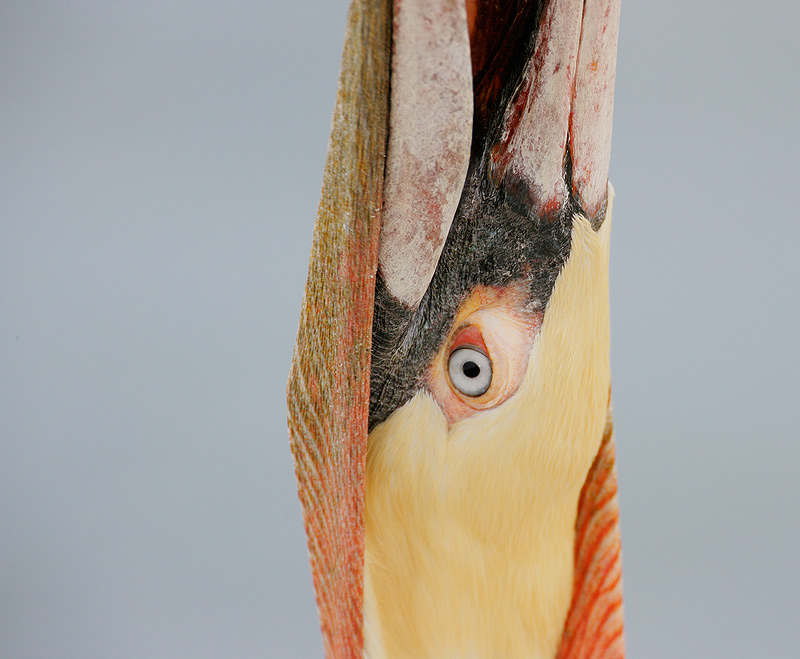
Brown Pelican, face during head throw, La Jolla, CA
Image Copyright 2008: Arthur Morris/BIRDS AS ART
Canon 500mm f/4 L IS lens with the 2X II TC and the EOS 1Ds Mark III. ISO 800. Evaluative metering +1 stop: 1/250 sec. at f/9. Gitzo 3530 LSV CF tripod and Mongoose M 3.5 head.
When you are working at 1000mm and a nearby pelican does a head throw, it is sort of like being caught with your pants down... So I focused and made an image, enoying the freedom of digital and wound up with an image that I liked a lot. The opportunity to create images like this may soon become a thing of the past. See item next.
LaJolla CLIFFS UPDATE
In Bulletin 253 there was a photograph of a new sign at the LaJolla Brown Pelican site. You can read all about it here in the Bulletin Archives: http://birdsasart.com/bn253.htmI. I was not concerned with hopping the fence as no public law or code was noted on the sign. Unfortunately, Phil Colla of San Diego e-mailed last week with news that a new sign (see below) has been erected at the site and this one notes S.D.M.C. 52.30.1. Assuming that the initials stand for San Diego Marine Code there is a good chance that enforcement may be imminent. Phil went on to say that photographers have been hopping the fence with impunity without any interference. In any case this is potentially a huge loss for nature photographers. Phil has graciously agreed to keep me informed and I shall keep you all informed via Bulletin.
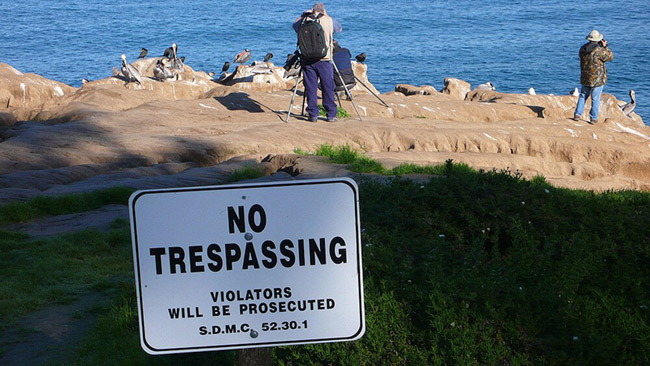
Sign, La Jolla, CA
Image courtesy of and Copyright 2008: Phillip Colla
PHOENIX PROGRAM & IN THE FIELD WORKSHOP
I am doing a one-day seminar for the Digital Imaging Group on Saturday, March 8th, 2008. I am not sure if there is any room on Saturday, but there are two In-the-Field Workshops scheduled as below. There are five openings for the Sunday I-T-F W. You can e-mail DIG as follows for info on the Saturday seminar: Chuck Williams at Chuckwill@cox.net, Howard Wood at woodpileimages@cox.net , or Lynn Thompson at lyn2th@aol.com.
Friday March 7, 2008 1-DAY (Limit: 6/Sold Out): $400/person
Sunday March 9, 2008 1-DAY (Limit: 6/Openings: 5)): $400/person
Each ITF I-W Day shall consist of a morning and an afternoon three-hour photography session at locations to be determined. Bring your laptop for image-sharing at lunch.
Registrations may only be made by phone directly through BIRDS AS ART. To register for the Sunday Phoenix ITF-I-W call us at 863-692-0906 with a credit card during business hours. Be sure to have your e-mail address handy.
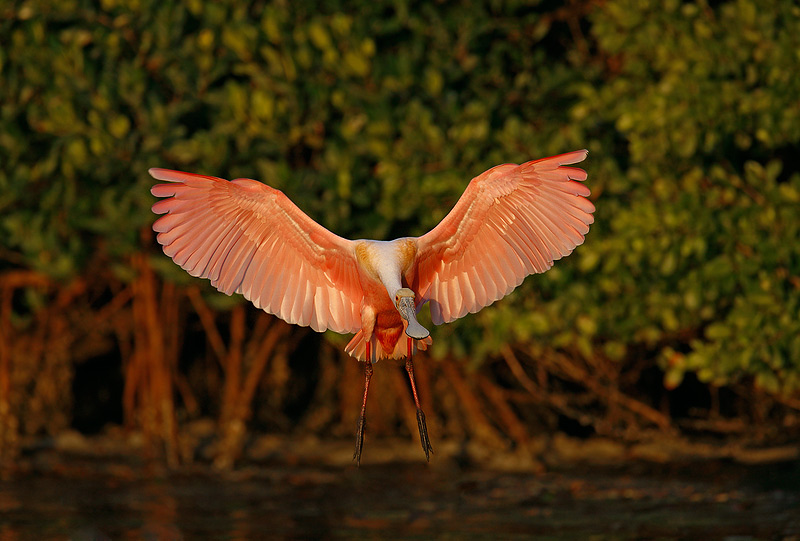
Roseate Spoonbill landing, early morning light, Tampa Bay, FL
Image Copyright 2008: Arthur Morris/BIRDS AS ART
Canon 500mm f/4L IS lens with the 1.4X II TC and the EOS 1Ds MIII. Evaulative Metering + 2 stops off the sky above the mangroves: 1/800 sec. at f/7.1. Mongoose M3.5 and Gitzo 3530 LSV CF tripod. Slight crop and got rid of two partial bird heads from the lower left-hand corner.
.
I joined James Shadle for a trip on Tampa Bay aboard James' flats boat Hooptie on the morning of January 31. We are glad to report that the spoonies are in and getting gorgeous.
BIRDPHOTOGRAPHERS.NET/IT AIN'T JUST BIRDS UPDATE
BPN continues to take the world of nature photography by storm. In just a shade more than five weeks almost 3,000 folks have become involved, and many are extremely happy with what we are doing.
You can enjoy some of the fun at Layton Parham's fine "Needs Anger Management" American alligator post here: http://www.birdphotographers.net/forums/showthread.php?p=30825&posted=1#post30825. It is a great image with one obvious flaw. The problem is that nobody can spot the flaw. Can you?
Among many interesting threads in the General Photography Discussion Forum is "Important Issue for all BPN Members and Contributors." If you take a few minutes to read all 40 responses it will give you a great idea of what BPN is about: http://www.birdphotographers.net/forums/showthread.php?t=4081.
And if you have trouble understanding what a proper head angle is, check out the "Head Angle Police Tutorial" thread in Eager to Learn: http://www.birdphotographers.net/forums/showthread.php?t=4242. Best to check this one out from the bottom up for some great examples of good and of unfortunate head angles.
Many of our folks are thrilled with the gentle but honest critiques that they have been receiving on their posted images. Below are a few:
Christopher C.M. Cooke: "Thanks Artie. Unlike all other sites I have been a member of, this one is like a jigsaw puzzle where the pieces actually seem to fit. I keep copies of every critique on a pdf file and it is simply fantastic. The attitude of all the folk here is TOTALLY constructive and very genuine whereas on other sites one is either put down or in receipt of gratuitous and insincere praise. This place is very special indeed." Chris.
Marko Matesic: "Thanks guys your precious comments and kind words...they keep me going ! It is great privilege to hear critiques,comments,compliments from BIG guys like you... I am learning every day with every comment and new capture!" THX, Marko.
Terry Olmsted: "Thanks Josh, Maxis, Fabs, and Judy for the encouraging and helpful comments! The BPN interaction is a great learning experience." Terry
Via private message to Axel Hillebrandt, one of our very finest moderators: ...thanks for taking the time to view and comment on my images. I've learned more in the past few days than I've learned in the past year. It's nice getting comments on how to improve the images that you've captured.
John Chardine: Can I say how much I am enjoying this site and learning huge amounts along the way? Thanks for everyone's comments." John
And here are just a few of my favorite images:
Check out Krijn Trimbos fabulous Great-crested Grebe with nesting material here: http://www.birdphotographers.net/forums/showthread.php?p=30866#post30866
Another of moderator Jody Melanson's absolutely sick Snowy Owls: http://www.birdphotographers.net/forums/showthread.php?t=4564
And Milo Burcham's priceless Happy Otter here: http://www.birdphotographers.net/forums/showthread.php?t=4569
The is lots of way out stuff in Out of the Box. Among them are Posse member Al Forns' killer GBH silhouette: http://www.birdphotographers.net/forums/showthread.php?t=4378 and Dr. Steve Bein's intriguing Male Cardinal (in the round): http://www.birdphotographers.net/forums/showthread.php?t=3881
BirdPhotographers.Net/It Ain't Just Birds (www.BirdPhotographers.Net) has quickly become the number one educational and critiquing web site on the planet and is aiming to improve. A quick visit to any of the galleries will reveal that our philosophy of "honest critiques done gently" and leading by example are succeeding quite well. (If you are a first time visitor, you will be prompted to register. Registration is free. Folks who will be using our image hosting services or otherwise wish to support our efforts are invited to become members by clicking here: http://www.birdphotographers.net/forums/membership.aspx). Though membership is free up until April 1, 2009, more than 375 folks have already shown their support for BPN by joining as members ($20 annually).
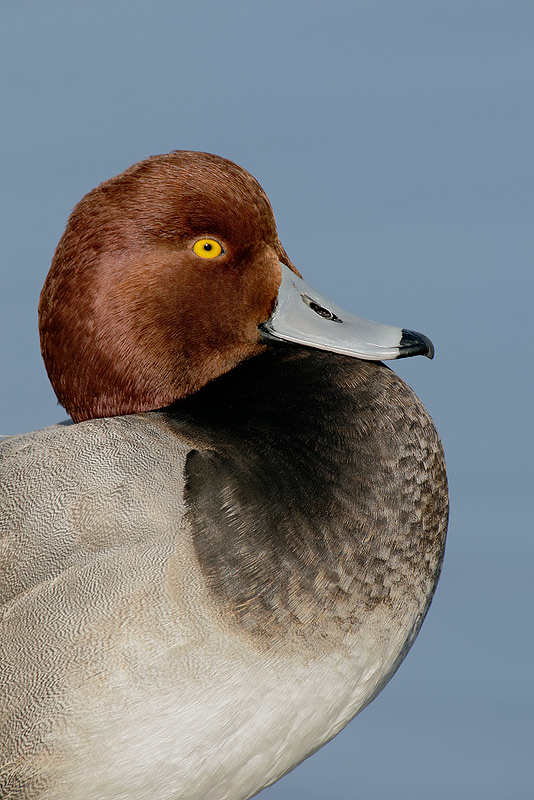
Redhead drake, tight vertical front-end portrait, San Diego, CA
Image Copyright 2008: Arthur Morris/BIRDS AS ART
Canon 500mm f/4
L IS lens with the 2X II TC and the EOS 1D Mark III. ISO 400. Evaluative
metering +2/3 stop: 1/200 sec. at f/11. Gitzo 3530 LSV CF tripod and Mongoose M
3.5 head.
I lowered the tripod and got down on one knee to soften up the background (by "moving" the background relatively farther from the bird). Had I made the image from a standing position the background would have been ugly black muck. Note the perfect head angle with the head turned just a few degrees towards me.
GALAPAGOS 2008
Amazingly, there is a single opening for a male roommate due to a cancellation for this summer’s Galapagos Photo Cruise, July 2-12, 2008. One week on the boat: $5499.00. This trip had been sold out for more than a year. Sorry ladies <smile>. Please call immediately if you are interested: 863-692-0906.
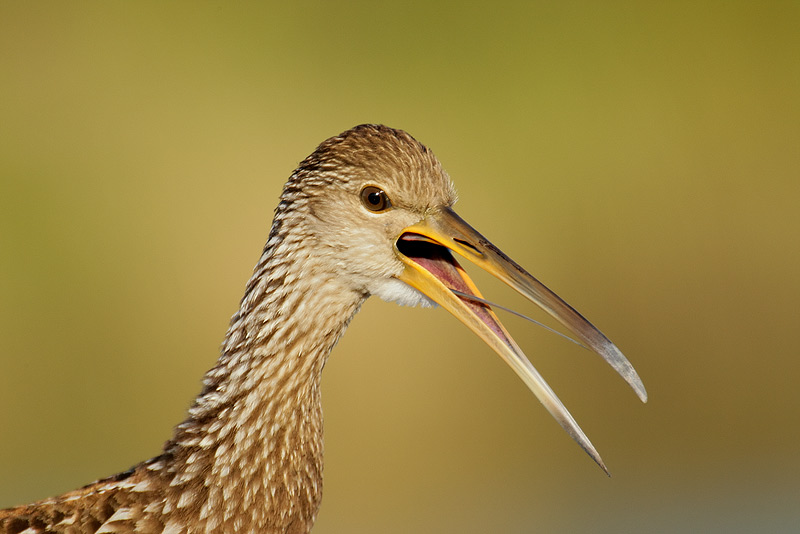
Limpkin calling, Indian Lake Estates, FL
Image Copyright 2008: Arthur Morris/BIRDS AS ART
Canon 500mm f/4
L IS lens with the 2X II TC and the EOS 1D Mark III. ISO 400. Evaluative
metering +2/3 stop: 1/400 sec. at f/10.
I created this image from my Sequoia using the BLUBB (Big Lens Ultimate Beanbag) on the window. When working from a vehicle you can maintain some control of the background tonalities by raising and lowering the window. You can learn more about the BLUBB here: http://www.birdsasart.com/blubb.htm. Do beware of cheap imitation rip-offs; you will get exactly what you pay for.
JOB OPENING: VIREO COLLECTION MANAGER
Collection Manager VIREO (VIsual REsources for Ornithology) Position announcement #960. Issue Date: January 7, 2008. Applications will be accepted until position is filled.
The Collection: VIREO, The Academy of Natural Sciences' ornithological image collection, is the world's most comprehensive collection of bird photographs. It includes more than 130,000 images of which 55,000 are currently online. The Academy also has thousands of non-bird images, only some of which are online.
Responsibilities: Manage and care for collections of ornithological photographs and other Academy photos and related databases. Duties include: soliciting, and accessioning photographic contributions, communicating with contributors and users, data entry, working on database structure, marketing images, refining the web site, and other duties as assigned. Fill in for Director in his absence and assist in management of the Academy's intellectual property rights.
Qualifications: Good working knowledge of bird identification. High proficiency with computers in some or all of the following areas: databases, Photoshop, HTML, computer programming. Experience in marketing and knowledge of intellectual property rights issues highly desirable. Ability to work well with others. Bachelor's degree in field related to duties.
To Apply: Send letter of interest, resume, and names and full contact information for three references to: Doug Wechsler, Director, VIREO, The Academy of Natural Sciences, 1900 Benjamin Franklin Parkway, Philadelphia, PA 19103, (215) 299-1069, vireo@ansp.org, http://www.ansp.org/about/employment.php#960, www.acnatsci.org/vireo
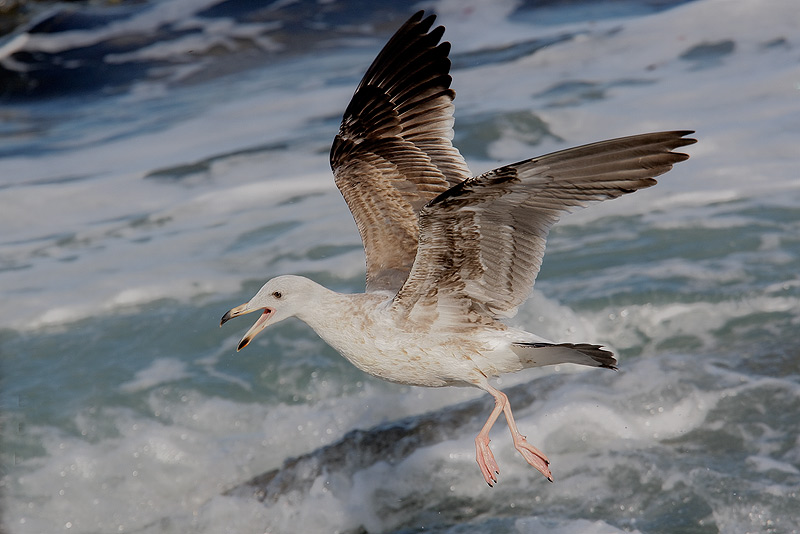
Western Gull, immature over surf, La Jolla, CA
Image Copyright 2008: Arthur Morris/BIRDS AS ART
Canon 70-200mm
f/4 L IS lens with the 1.4X II TC (handheld at 235mm) and the EOS 1D Mark III.
ISO 400. Evaluative Metering +1/3 stop: 1/1600 sec. at f/7.1; set manually after
histogram check.
.
Without much wind, we were not getting the gulls to hover as we fed them so we began tossing bits of bread into the surf and making images as they went after it. Here I wish that the bird’s head were turned a bit more towards me.
INFRARED D-60 BODY FOR SALE
Dane Johnson has a used Canon EOS D60 (body only) converted to IR black-and-white for sale. He is asking $650. It comes in the original box and is in excellent condition. D-60 bodies have recently been selling on eBay for an average of $267. The IR Conversion was done by the IRGuy in the summer of 2005; the current price for the conversion is $500. Also included are two dedicated Arca Swiss style quick release plates. One, from Really Right Stuff, is an L-plate that allows the camera to be mounted either horizontally or vertically and sells for $140. The second is a conventional bottom plate from Kirk Enterprises that allows the camera to be mounted horizontally only ($55.00 list). Total value of the items is $962. Shipping costs will be as per the local UPS Pack and Ship to your location with insurance. Will accept PayPal or personal check/cashier’s check (will hold item until check clears bank). Recent samples of the images captured by the camera will be sent on request. Any questions, contact Dane at danaphoto@sbcglobal.net , or call 559-445-5525 (work), 559-593-0989 (cell), or 559-299-8861 evenings.
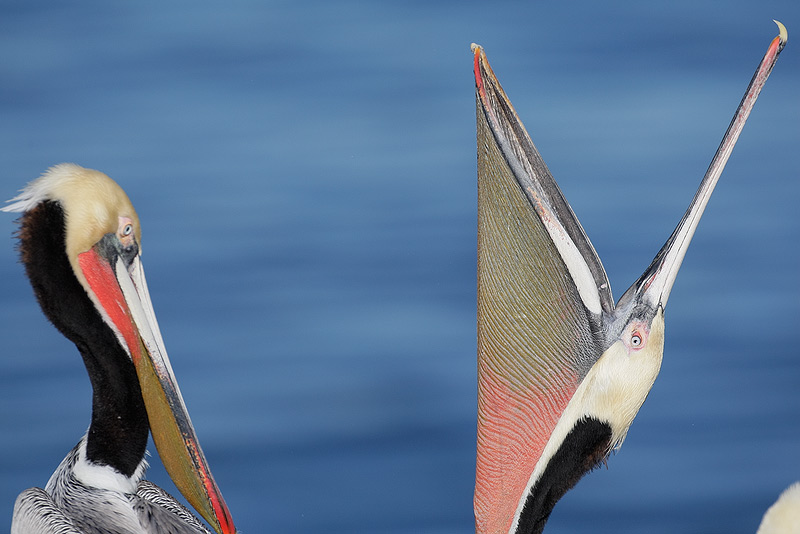
Brown Pelican, head throw, La Jolla, CA
Image Copyright 2008: Arthur Morris/BIRDS AS ART
Canon 500mm f/4 L IS lens with the EOS -D Mark III. ISO 200. Evaluative metering +1/3 stop: 1/1250 sec. at f/4. Gitzo 3530 LSV CF tripod and Mongoose M 3.5 head.
With digital, you think much differently than with film. When I saw this head throw, I just tried to get the bird in the frame and to depress the shutter button when the bird was clear of any merges with the two other birds in the frame. When I saw that I had not clipped the tip of the bill, I knew that I would be able to create a successful image. I used the techniques described in Robert O'Toole's APTATS PDF (http://www.birdsasart.com/aptats.htm) to create the image below. Note that by properly exposing to the right (as above) your converted RAW images will look washed out…
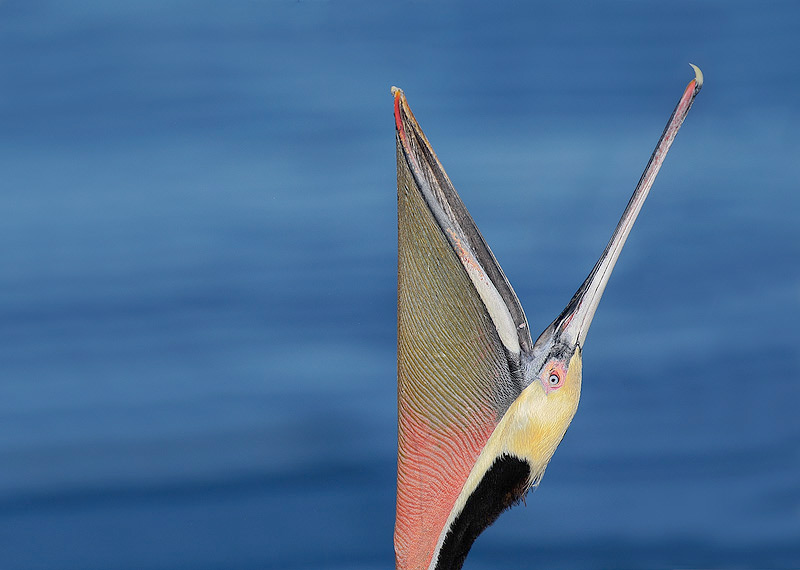
IPT UPDATES
Bosque IPT
#1:
Bosque IPT #2: NOV 29-DEC 2, 2008. (Slide program on the evening of NOV 28) 4-DAY: $1799 (Limit: 10/Openings: 4)
(As always, BAA reserves the right to exceed the posted limit by one.)
Important Note: If you have already registered for the 2008 Post X-mas IPT please shoot us an e-mail. Thanks; we may have lost track of two registrations…
With me leading fewer IPTs and with reduced group sizes, the IPTs above will surely sell out well in advance. Announced less than a week ago, the three IPTs above are already 43% sold out… If you are seriously interested in joining me in the field, it would be best to register immediately.
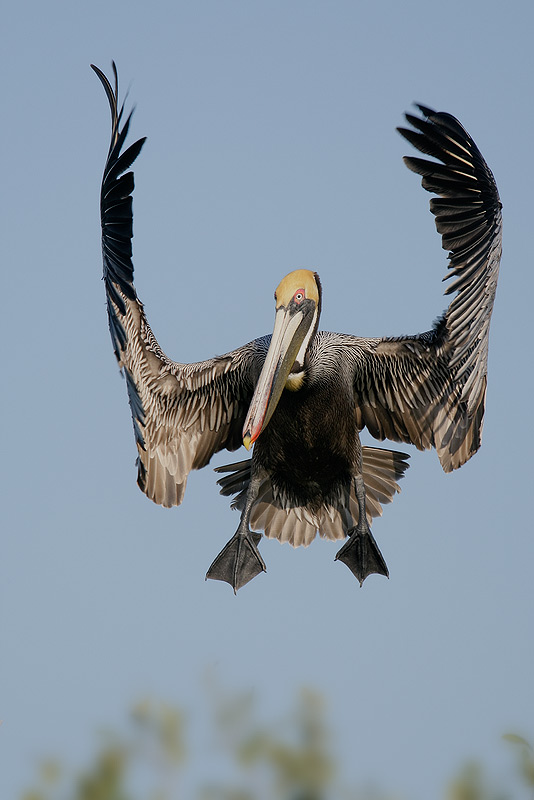
Brown Pelican, vertical original, Tampa Bay, FL
Image Copyright 2008: Arthur Morris/BIRDS AS ART
Canon 500mm F/4 L IS lens with the 1.4X II TC and the EOS 1DMIII. Gitzo 3530 LSV tripod with Mongoose M3.5 head. ISO 500. Evaluative metering +1 stop of the sky (we had a slight haze): 1/1000 sec. at f/7.1 confirmed by histogram check.
This image was made on Tampa Bay with James Shadle last week aboard his flats boat Hooptie. I had moved in close to photograph the landing cormorants when a bunch of pellies started landing. Too close for horizontals I rotated to VERT in hopes of making a few large in the frame images with both wings cut off equally. Imagine my surprise when I chimped on this one! You gotta love digital... The sharp mangroves in the original file were selected with a Quick Mask and softened with a 30 pixel Gaussian Blur.
.....
Best and love and great
picture-
artie
Note: Arthur Morris has been a
Canon contract photographer since 1996 and
continues in that role today. Hunt's Photo of Boston, MA is a BAA sponsor as is
Delkin Devices. Back issues of all BAA Bulletins can be found in the Bulletin
Archives which